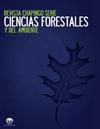Astraeus aff的外生菌根联合。墨西哥Altiplano Potosino的一片橡树林遗迹中的hytrometricus(Pers.)Morgan
IF 0.6
4区 农林科学
Q3 Agricultural and Biological Sciences
Revista Chapingo Serie Ciencias Forestales Y Del Ambiente
Pub Date : 2022-04-30
DOI:10.5154/r.rchscfa.2021.04.022
引用次数: 0
摘要
简介:在Altiplano Potosino的高山山脉中,有Quercusspp的残余森林。到目前为止,与这些生态系统相关的外生菌根真菌的种类尚不清楚。目的:了解黄芪的形态学特征。在Altiplano Potosino的三个降水稀少的地点,与Quercus物种相关的Hytrometricus(Pers.)Morgan。材料和方法:在雨季采集橡树的外生菌根真菌和营养结构,进行形态学鉴定。通过Tukey方差分析和最小显著差异(P=0.05)评估土壤理化变量,以确定研究地点(Cerro El Peñon Blanco、Sierras de Guanamé和La Mojonera)之间的差异。结果与讨论:外生菌根菌种A.aff。潮湿病与波菌Quercus potosina Trel。,Q.pringlei SeemenexLoes。,Q.tinkhamii C.H.Muller和Q.stritula Trel。每个担子菌有5到14个laciniae,直径范围如下:13到20mm(内孢子),42.3到57.4mm(外孢子),8到10.1μm(孢子长度),4.4到6.9μm(内孢子菌丝)和4.9到9.2μm(外孢子菌丝)。在pH为5至7.7、低氮(<2%)和高磷(85 mg∙kg-1)的易碎土壤(沙质至粘性)中发现了橡树和真菌物种。结论:A.aff的外生菌根结合。潮湿的橡树物种解释了这些灌木橡树林在研究地点的半干旱环境下的生存。本文章由计算机程序翻译,如有差异,请以英文原文为准。
Ectomycorrhizal association of Astraeus aff. hygrometricus (Pers.) Morgan with an oak forest relict in the Altiplano Potosino, Mexico
Introduction: In the high mountain ranges of the Altiplano Potosino there are relict forests of Quercusspp. The species of ectomycorrhizal fungi associated with these ecosystems are so far unknown. Objective: To know the morphology of Astraeus aff. hygrometricus (Pers.) Morgan associated with Quercus species in three sites of scarce precipitation in the Altiplano Potosino. Materials and methods: Ectomycorrhizal fungi and vegetative structures of oak were collected during the rainy season for morphological characterization and identification. Soil physicochemical variables were evaluated by Tukey’s analysis of variance and least significant difference (P = 0.05), to identify differences among the studied sites (Cerro El Peñon Blanco, Sierras de Guanamé and La Mojonera). Results and discussion: The ectomycorrhizal species A. aff. hygrometricus was associated with Quercus potosina Trel.,Q. pringlei SeemenexLoes., Q. tinkhamii C. H. Muller and Q. striatula Trel. The fungi had five to 14 laciniae per basidiomata and the following diameter ranges: 13 to 20 mm (endoperidium), 42.3 to 57.4 mm (exoperidium), 8 to 10.1 μm (spore length), 4.4 to 6.9 μm (endoperidium hyphae) and 4.9 to 9.2 μm (exoperidium hyphae). Oak and fungal species were found in friable soils (sandy to clayey) with pH 5 to 7.7 and low nitrogen (<2 %) and high phosphorus contents (85 mg∙kg-1). Conclusion: The ectomycorrhizal association of A. aff. hygrometricus with oak species explains the survival of these shrub oak forests under the semi-arid environments of the studied sites.
求助全文
通过发布文献求助,成功后即可免费获取论文全文。
去求助
来源期刊
CiteScore
1.20
自引率
16.70%
发文量
0
审稿时长
>12 weeks
期刊介绍:
The Revista Chapingo Serie Ciencias Forestales y del Ambiente (RCHSCFA) is a scientific journal that aims to raise awareness of high-quality research products related to forest, arid, temperate and tropical environments in the world. Since its foundation in 1994, the RCHSCFA has served as a space for scientific dissemination and discussion at a national and international level among academics, researchers, undergraduate and graduate students, forest managers and public/private entities that are interested in the forest environment.
All content published in the journal first goes through a strict triple-blind review process and is published in the following formats: Scientific Articles, Review Articles, Methodologies, Technical or Technological Notes.

 求助内容:
求助内容: 应助结果提醒方式:
应助结果提醒方式:


